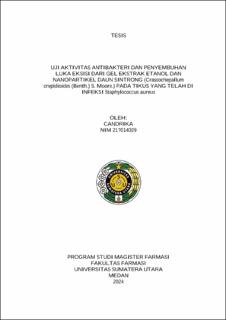Uji Aktivitas Antibakteri dan Penyembuhan Luka Eksisi dari Gel Ekstrak Etanol dan Nanopartikel Daun Sintrong (Crassochepallum crepidioides (Benth.) S. Moore.) pada Tikus yang Telah di Infeksi Staphylococcus aureus
Antibacterial and Wound Healing Activity of Extract Ethanol and Nanoparticles of Sintrong Leaves (Crassochepallum crepidioides (Benth.) S.Moore.) Gel on Rats Infected By Staphylococcus aureus

Date
2024Author
Candrika, Candrika
Advisor(s)
Dalimunthe, Aminah
Bangun, Hakim
Metadata
Show full item recordAbstract
Sintrong leaves (Crassochepallum crepidioides) are plants that have proven efficacious in the treatment of wounds empirically and experimentally known to contain secondary metabolite compounds alkaloids, flavonoids, tannins, steroids, glycosides, these compounds play a role in helping the wound healing process. In an effort to increase the optimal effect of herbal medicine, a development is needed, one of which is the use of nanoparticles using the High Energy Ballmill method as a drug carrier and drug delivery system. The advantages of sintrong leaf nanoparticles with the High Energy Ballmill method are able to increase the contact surface area, and increase drug absorption, but there has been no further research or development into pharmaceutical preparations.
The purpose of this study was to compare the antibacterial activity of ethanol extract with sintrong leaf nanoparticles against Staphylococcus aureus bacteria and the excision wound healing test of ethanol extract gel and sintrong leaf nanoparticle gel against excision wounds infected with Staphylococcus aureus.
The ethanol extract of sintrong leaves was obtained by maceration method using 96% ethanol solvent. Then the sintrong leaf simplisia powder was processed into sintrong leaf nanoparticles using a High Energy Ballmill at 800 rpm for 60 minutes followed by an antibacterial activity test of ethanol extracts and sintrong leaf nanoparticles against Staphylococcus aureus using the agar diffusion method. Ethanol extract and sintrong leaf nanoparticles were formulated into gel preparations using carbopol 940 polymer with concentrations of 10, 20, 30% followed by antibacterial activity tests. Then testing the wound healing activity of excision with a wound depth of 1mm and a width of 2 cm. Furthermore, the wound was infected with Stapylococcus aureus bacteria, after infection, treatment was carried out for 15 days and observations of wound diameter reduction on days 0, 3, 5, 10, 15.
Ethanol extract and sintrong leaf nanoparticles have antibacterial activity. Ethanol extract with KHM value 0.914% and nanoparticles KHM 0.999% the higher the concentration of extracts and nanoparticles, the higher the diameter of the inhibition zone produced. The gel is stable during storage for 12 weeks, the extract gel and nanoparticle gel have activity against excision wound healing, the percent of wound healing shows that the higher the concentration of extract gel and nanoparticle gel, the percentage of healing increases. Histopathology showed an increase in the value of collagen, fibroblasts and angiogenesis as the concentration of the preparation increased. It is concluded that the extract gel and nanoparticle gel of sintromg leaves have the potential in healing excision wounds infected with Staphylococcus aureus bacteria.
Collections
- Magister Theses [371]
